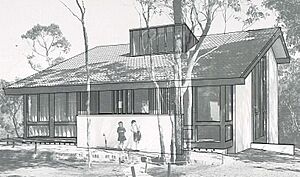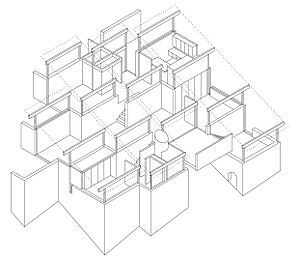Ken Woolley facts for kids
Quick facts for kids
Ken Woolley
|
|
|---|---|
| Born |
Kenneth Frank Charles Woolley
29 May 1933 |
| Died | 25 November 2015 (aged 82) Sydney, Australia
|
| Nationality | Australian |
| Occupation | Architect |
| Known for | Pettit & Sevitt houses, Ancher Mortlock Woolley architecture firm and the Sydney School |
Kenneth Frank Charles Woolley (born May 29, 1933 – died November 25, 2015) was a famous Australian architect. He worked for 60 years and is best known for designing many homes, especially with a company called Pettit and Sevitt. He also won the Wilkinson Award four times for his amazing designs, including three times for his own house! His first award-winning home was the 1962 Woolley House in Mosman.
Ken Woolley was a key person in developing the "Sydney School" movement. This style of architecture focused on building homes that fit well with the Australian landscape and used natural materials.
Contents
Ken Woolley's Architecture Journey
Ken Woolley was born in Sydney on May 29, 1933. He went to Sydney Boys High School and later studied architecture at the University of Sydney's School of Architecture. He finished his studies in 1955.
After graduating, he worked for the New South Wales government. There, he helped design important buildings like the Fisher Library at the University of Sydney and the State Office Block on Macquarie Street (which isn't there anymore).
In 1964, he joined a well-known architecture firm called Ancher Mortlock Murray & Woolley. This firm designed many amazing buildings that won major awards. Some of their famous projects include:
- The Australian Embassy in Bangkok
- Town Hall House in Sydney
- The Park Hyatt Hotel at Campbell's Cove
- The ABC Radio and Orchestra Centre in Ultimo
- Parts of the State Library of Victoria
- The Control Tower at Sydney Airport
- Buildings for the Sydney Olympics, like the Hockey Stadium.
One of their recent awards was in 2006 for their work on the State Library of Victoria, which won the Lachlan Macquarie Award for Heritage Architecture.
Cool Projects Ken Woolley Designed
Even while working for the government, Ken Woolley took on many other projects. He became very good at designing houses. In 1958, he won a competition for a low-cost exhibition house. This led to him being asked to design homes for a special display village in Carlingford in 1961. This event was a big success! It showed people that architect-designed "project houses" were a great choice, different from the usual homes built at the time.
That same year, he started working with a company called Pettit and Sevitt. Together, they created high-quality, well-designed homes. Their early house styles, like "Split Level" and "Lowline," used simple designs, natural materials, and focused on being practical.
These homes were affordable because they used standard materials like brick walls, plasterboard inside, concrete roof tiles, and aluminum windows. They often had simple shapes, flat roofs, and were designed to fit easily on different types of land.
People could even talk to an architect to choose details for their home, making them feel special. This smart way of selling and designing made these houses super popular, even with famous architects around the world!
In 1962, Ken Woolley finished building his own home, the Woolley House in Mosman. This house became very famous and helped him become a leader in the "Sydney School" movement. This style mixed ideas from different architecture types, like organic architecture (buildings that look like they grew from nature) and brutalism (using raw concrete). It aimed to create cozy homes that connected with the Australian bushland.
The Woolley House was designed around a series of garden terraces. Many parts of the timber roof sloped like the land. The house had a clever layout using 12-foot square sections that made up the main living area. It used natural materials like dark tiles, cedar wood, and painted bricks, making the house feel warm. The open living spaces had different ceiling heights and directions, making narrow areas feel much bigger.
The Woolley House won the RAIA’s Wilkinson Award the same year it was finished. In 2016, the Hesketh family gave the house to the University of NSW.
After joining Ancher Mortlock & Woolley in 1964, Ken Woolley and his partners became known for designing special buildings. Some important examples include:
- The Australian Broadcasting Corporation (ABC) Ultimo Centre
- The RAS Dome and Exhibition Hall
- The Olympic Hockey Stadium at Homebush.
Ken Woolley also designed cool concrete buildings, like those at Newcastle University and Macquarie University. He worked on apartment buildings like The Penthouses in Darling Point (1967) and buildings that showed off new technology, such as Town Hall House. Many of these projects won awards over the years.
Some of his other famous buildings in Sydney include:
- The Garvan Institute of Medical Research building in Darlinghurst, which has an amazing DNA-inspired spiral staircase.
- The Fisher Library at the University of Sydney.
- The Park Hyatt Sydney.
- The Sydney Airport Air Traffic Control Tower.
He also worked on parts of the State Library Victoria and the Australian Embassy in Bangkok.
In 1993, Ken Woolley received the highest award in Australian architecture, the RAIA Gold Medal.
Important Projects
Here are some of the key projects Ken Woolley worked on:
As Design Architect for the Government Architect's Office:
- 1957–1962 Fisher Library, University of Sydney
- 1960–1965 State Office Block, Macquarie Street
With Ancher Mortlock and Woolley:
- 1962 Woolley House, Mosman
- 1962–1977 Over 3500 Pettit & Sevitt houses
- 1965–1988 Student Unions at Macquarie, Newcastle and Sydney Universities
- 1968 The Penthouses, Rushcutters Bay
- 1971 Town Hall House, Sydney
- 1973 New Australian Embassy, Bangkok
- 1987 Park Hyatt Hotel at Campbell’s Cove, Circular Quay, Sydney
- 1988 ABC Radio and Orchestra Centre, Sydney
- 1993 Control Tower, Sydney Airport
- 1994 Garvan Institute of Medical Research, Darlinghurst
- 1996 Exhibition Hall Dome & Olympic 2000 Indoor Sports halls, Homebush Bay
- 1998 Hockey Stadium, Olympics 2000, Homebush Bay
- 2004 Queen Victoria Building, Sydney. Refurbishment
- 2005 Completion of State Library of Victoria (work started in 1985)
Architecture Awards
Ken Woolley won many important awards for his designs:
National Awards:
- Sir Zelman Cowen Award for Public Architecture (1986)
- Robin Boyd Award (1987)
- Lachlan Macquarie Award for Heritage Architecture (2005)
- National Award for Enduring Architecture (2022) for the Woolley Hesketh House, Mosman (1962)
New South Wales State Awards:
- New South Wales Enduring Architecture Award (2022) for the Woolley Hesketh House, Mosman (1962)
- Wilkinson Award (won four times!):
- 1962, Woolley Hesketh House, Mosman
- 1968, The Penthouses, Rushcutters Bay
- 1982, Woolley House, Paddington
- 1987, Woolley House, Palm Beach
- Sir John Sulman Medal (1963) for Fisher Library, University of Sydney
- Blacket Award for Country Buildings (1967, 1969, 1987)
- Civic Design Award (1978)
- Project House Awards (1967–1977) – 14 awards for Pettit & Sevitt houses!
ACT Awards:
- Sir Roy Grounds Award for Enduring Architecture (1997, 2002, 2010)
Merit Awards for various types of buildings:
- He received many Merit Awards for homes, commercial buildings, public buildings, and renovated buildings between 1972 and 1993.
Personal Achievements
- 1988: Became a Member of the Order of Australia (AM)
- 1993: Awarded the Australian Institute of Architects Gold Medal
- 2001: Became a Fellow of the Academy of Technological Science and Engineering
- 2003: Received the Centenary of Federation Medal for his contributions to structural engineering.
Architecture Competition Wins
Ken Woolley won many design competitions, showing his skill and creativity:
- 1958: Taubmans Australian 'Low Cost' House Competition
- 1966: Daily Telegraph House
- 1986: Victorian State Library and Museum, Melbourne
- 1987: Australian/Hellenic War Memorial Competition, Canberra
- 1987: Campbell’s Cove Hotel Competition, Circular Quay, Sydney
See also
- Sydney Ancher
- Bryce Mortlock
- Woolley House
- Wilkinson Award
- Australian Institute of Architects
- Australian Institute of Architects Gold Medal
- Member of the Order of Australia




